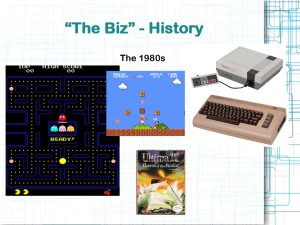Making Money Make Games – Part 2 (More History)
Posted by Rampant Coyote on December 10, 2014
Okay, this is the part of the story where I personally started paying attention and getting involved, if only as a consumer. At this point, especially as things were starting out the decade, there was still a huge question of what kind of industry “video games” were going to be. Like book publishing? Like toys? Consumer electronics, like televisions? Appliances? Rock & Roll? Coin-op amusements? All of the above (and many more approaches) were tried. The industry grew, and stabilized somewhat, especially when the periodic downturns hit and forced consolidation.
Notable games of the era are so numerous I’m not sure where to begin, and I’m going to be leaving off some big ones just to list off the variants. But: Pac-Man, Ultima, Wizardry, Galaga, Dig-Dug, Star Wars, Asteroids, Elite, Pitfall!, Sim City, Commando, R-Type, M.U.L.E., Donkey Kong, Super Mario Brothers, King’s Quest, Jawbreaker, Tetris, Defender, Dragon Warrior, Dragon’s Lair, Final Fantasy, Street Fighter, Legend of Zelda, John Madden Football, etc. etc. etc.
Platforms included arcade machines (often with programmable hardware rather than custom solutions), consoles (Colecovision, Intellivision, Vectrex, Atari 7200, ), handheld (custom hardware galore, the “Game & Watch”, the ultra-popular Nintendo Gameboy, and Atari Lynx), and Computers (VIC-20, TRS-80 Color Computer, Commodore 64, Sinclair Zx80 / ZX81, TI-994a, Amstrad, Apple Macintosh, etc…), and the platforms of the 1970s that hadn’t yet been discontinued. But the decade ended with a strong finish with the Nintendo Entertainment System (NES), the Sega Master System, and the Sega Genesis.
Development team sizes ran the gamut at this point, from one programmer and an artist to a moderately-sized (by today’s standard) teams and subcontractors. While the big publishers were taking over the scene, the beginning of the era was dominated by small teams and small publishers selling games however they could – including mail order. That model hadn’t completely disappeared at the close of the decade. A new term was devised in an era of dial-up networking and “sneakernet” (floppy disks delivered by somebody wearing sneakers) that allowed grassroots distribution: Shareware.
Now, my heart may always belong in the arcade of the 1980s, but honestly, if I were to pick a “golden age” of gaming, it would be the early to mid 1990s. Like, 1990 to 1996 or so. However, if you were to ask the games biz what sort of industry it was like around the middle of the decade – or at least what industry it wanted to be like, there’d be one answer an order of magnitude more common than any other: HOLLYWOOD! The games industry wanted to be like Hollywood, but (IMO) it tried to cherry-pick the “best” parts of Hollywood (from the corporate perspective), not realizing that a lot of bad came with the good.
Notable games from this era were plentiful and awesome. I’m gonna just note Twisted Metal, Warhawk, and Jet Moto for the record, because while they were only moderate hits, in my little biased world they dominate my memories of the era. So there. 🙂 Many of the big names were continuations of series from the earlier decade (Mario, Ultima, Legend of Zelda, Final Fantasy, Metal Gear, Street Fighter), but there were some fresh games and new series here as well that met with critical and / or commercial success: Doom, The Secret of Monkey Island, Links, Wing Commander, Warcraft, Oddworld, Quake, Diablo, Goldeneye 007, Crash Bandicoot, Master of Orion, Chrono Trigger, Fallout, Resident Evil, Unreal, Baldur’s Gate, Virtua Fighter, Panzer Dragoon, Smash TV, Mortal Kombat, Pokemon, Starcraft, Sonic the Hedgehog, Age of Empires, Gran Turismo, Grand Theft Auto, Half-Life, Spyro the Dragon, Roller Coaster Tycoon, Tomb Raider, Myst, X-Com, The Sims, and the list goes on and on…
The PC gradually became standardized (especially under Windows 95+), and came into its own as a great gaming platform, especially once 3D hardware caught on. The arcades and arcade games diminished significantly during the course of the decade, but were still a force. On the home console front, the big entries (at least in these parts) were the Super NES (AKA Super Famicom), Sega Saturn, Sega Dreamcast, Sony Playstation, Atari Jaguar, and the Nintendo 64. On the handheld side of things, notable entries included the Nintendo Gameboy Color, and Sega GameGear.
Throughout this era, most game studios grew to medium-sized to large teams. The publishers ruled the world. Exceptions existed, but even the successful smaller teams that kicked serious butt doing “shareware” titles grew to a much larger size over time. It was a time of massive growth — and, in my opinion, the origin of the indie “push back.” And boy, did they push back.
For the first half of the new millennium, things continued as one would predict from the 1990s. But then everything started to change. The era of the big publishers and ever-increasing budgets began to crumble. Where there was once something of a monolithic “games industry” of a few major warring publishers, things went really, really fuzzy. Digital distribution – via any number of mechanisms – fueled this change.
Notable games of the last fifteen years? Where do I begin?!?!? The names range from massive major studio productions down to tiny single-person development teams (or at least started there). Halo. Minecraft. Bejeweled. Bioshock. Call of Duty. Farmville. Angry Birds. Flappy Bird. And of course, plenty of older series from previous decades continue to be mined for value – from Legend of Zelda and Mario to Sim City and Grand Theft Auto.
Platforms become increasingly diverse in this era. You still have personal computers (running whatever flavor of Windows / Linux / Macintosh you want), and consoles (notably Playstation 2, 3, and 4, the Xbox series, the Nintendo Gamecube, Wii, and Wii-U), and tons of dedicated game handhelds (Gameboy Advance, DS, DS3, Sony PSP, Vita, etc.). But now you have things like browser-based and mobile gaming. And so-called “microconsoles” and virtual reality and “wearable computing” may yet be a thing.
And game development? It’s all over the board. Lone wolf developers may compete directly against giant 100+ member development teams with budgets into the hundreds of millions.
Common Threads
The rest of this series will be about the common threads running through all of these eras. At first glance, things seem like they’ve changed so much and the industry has redefined itself so many times there’s no way you can possibly nail down any sort of consistency.
But they are there. One thing that I’d like to note – as I’m still something of an “indie evangelist” – is that throughout all these eras, there’s been an indie contingent. From the hobbyists of the 1960s and 1970s to the mail-order guys of the 1980s to the shareware folks of the 1990s through the “indie revolution” of today – “indies” by any other name have been a constant.
Filed Under: Biz, Game Development, Retro - Comments: Comments are off for this article


